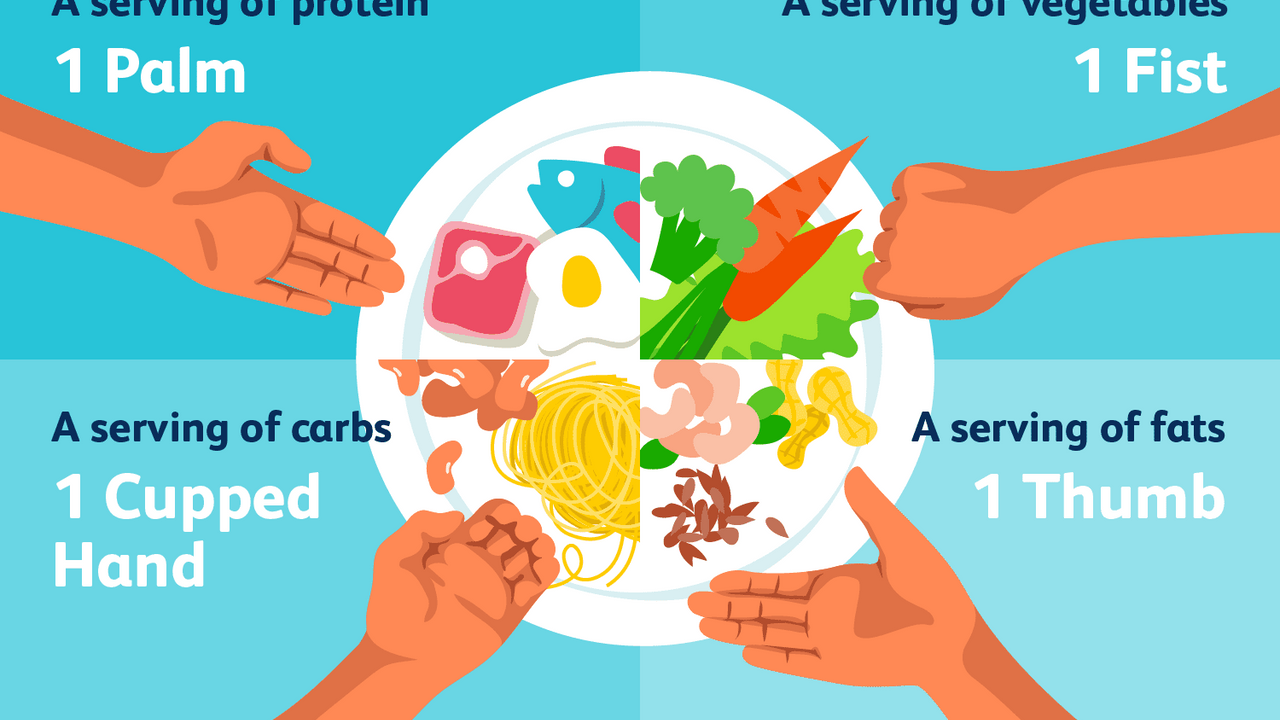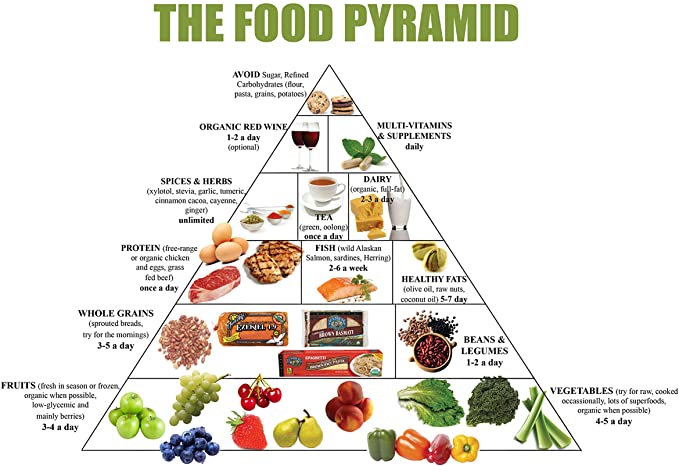Serving and Portion Sizes: How Much Should I Eat?
Sep 28, 2022
Now we start to get into the things you need to know to start to lose weight.
Knowledge and Action = Power.
Portions and Servings: What's the Difference?
A portion is the amount of food that you choose to eat for a meal or snack. It can be big or small, you decide.
A serving is a measured amount of food or drink, such as one slice of bread or one cup (eight ounces) of milk.
Many foods that come as a single portion actually contain multiple servings.
The Nutrition Facts label on packaged foods, on the backs of cans, sides of boxes, etc. tells you the number of servings in the container.
For example, look at the label of a 20-ounce soda (usually consumed as one portion). It has 2 servings and 240 calories in it. A 3-ounce bag of chips, which some would consider a single portion, contains 3 servings.
Read the full article here: National heart, lung and blood Institute Serving sizes and portions (I feel some of the ’20 years ago’ info is distorted in this article. I was around 20 years ago, and a soda was 12oz not 6.5. The can told you it was 2 servings, but few people drank it in 2 servings. Now cheeseburgers, yes, much bigger. But a 3” bagel? Bagels may be a bit bigger now, but not 2x. So, take it as info, but not totally accurate.)
Remember that just because it says there are 3 servings doesn’t mean that you are only supposed to eat one serving. Vegetable requirements per day are 3-5 cups, which means you could easily eat 2-3 servings in one meal. The same thing with fruits and grains. Multiple servings in one sitting is not a problem as long as you are not eating way too many servings over the course of the day.
You can eat as many vegetables as you want every day as long as you are not adding sugars or fats to them. You can not eat too much salad, but you can use too much dressing. Its not the salad that is fattening, it’s the dressing. When you add things to the salad, like cheese, nuts, dried fruit, etc, these are the things that rack up the calories, not the mixed lettuce. Even if you make a salad with lettuce, tomatoes, cucumber, radish, beets, it is still super healthy. You will get full before you can eat too much to gain weight. (for 98% of people)
Helpful Hints: Look at the size of the plates, bowls and glasses you use at home. How big are they? How many cups of food do you normally put in one of your bowls? On one of your plates? What do you normally drink, and how big is the glass? If these are all LARGE, perhaps you can buy new, smaller plates, bowls and glasses. Depending on your age, you may have a really small plate that matches the large plates. That is a 'salad' plate. That plate came with a plate set because you are supposed to eat a salad (greens) with your meal. That logic seems to have left the American diet except in certain restaurants.

CHOOSE SENSIBLE PORTION SIZES
Control portion size. See guideline “Let the Pyramid guide your food choices” for sensible sizes and numbers of servings.
- If you’re eating out, choose small portion sizes, share an entrée with a friend, or take part of the food home (if you can chill it right away).
- Check product labels (coming this week in part 2) to learn how much food is considered to be a serving, and how many calories, grams of fat, and so forth are in the food. Many items sold as single portions actually provide 2 servings or more. Examples include a 20-ounce container of soft drink (2.5 servings, a 12-ounce steak (almost 5 servings IF it is LEAN steak), a 3-ounce bag of chips (3 servings), and a large bagel (6 servings of grains).
- Be especially careful to limit portion size of foods high in calories, such as cookies, cakes, other sweets, French fries (12-15 = 1 serving), and fats, oils, and spreads.
IMPORTANT:
The carbohydrates, fats, and proteins in food supply energy, which is measured in calories. High-fat foods contain more calories than the same amount of other foods, so they can make it difficult for you to avoid excess calories. However, low fat doesn’t always mean low calorie. Sometimes extra sugars are added to low fat muffins or desserts, for example, and they may be just as high in calories.
Eating a variety of foods from each food group will help you get the nutrients you need.
The Dietary Guidelines describe the amounts recommended from different food groups. People 18-50 following the Healthy U.S.-Style Eating Pattern choose foods every day from the following:
- Vegetables — 3-5 cups
- Fruits — 2-4 cups
- Grains — 6 to 11 ounces
- Dairy — 2-3 cups (fat-free or low-fat)
- Protein foods — 5 to 6½ ounces
- Oils — 5 to 7 teaspoons
Does this mean you have to measure or weigh everything you eat? Not really. Some people find it helps to measure things carefully at first, but once you get used to your new eating plan, strict measuring probably won’t be necessary. But, what exactly is a serving? And is that different from a portion?
You can find what the serving size is from the Nutrition Facts label. Many times you will find that the serving size is much smaller than a portion size. Once you realize this, you may decide to make your portion size smaller to help limit calories, sugar, salt, saturated fat or one of the other nutrients on the label.
My recommendations: (pretty much the same as the USDA dietary guidelines, except I don't limit raw or plain cooked vegetables)
- Vegetables — at least 3-5 cups – Eat as many plain vegetables as you would like. Just don’t add oils, fats, or sugars to them. This is where the calories come from
- Fruits — 2-4 cups- fruits have natural sugars (and canned fruits will have added sugars) keep your fruits down around the recommended 2-4 cups. Your body might crave more if you are on a low/no sugar diet. Be extra careful with fruit juices. You can drink a lot more juice than you can eat fruit.
- Grains — 6 to 11 ounces- Most grains are empty calories. Bread. Much of our breads have added sugars and added fats. Look at your bread label and see if it has sugar. 20 yrs ago, bread did not have sugar. Then you have muffins, cakes, cookies, ect. that have added sugar AND fats. What you NEED to eat are whole grains. Oats are the BEST!! Oatmeal. Overnight oats. Quinoa. Rice, especially brown rice. The less processed your grain, the better it is for you. Highly processed grain has the nutritional stuff stripped off (because it has a much longer shelf life). But once the nutrients are stripped, it has no health value. Then they add sugar and fats that have a long shelf life. This is where grains are fattening.
- Dairy — 2-3 cups (fat-free or low-fat) 2-3 cups all day!! Dairy is fattening. Even the LOW FAT versions can have MORE CALORIES than the full fat. Beware of things they add to low fat to make them taste better. It’s the fat that makes it taste so good, so, marketing says label it low fat, but add other fattening things to make it taste better.
- Oils — 5 to 7 teaspoons –daily. Much controversy on whether it is good for you or not. The Mediterranean uses it in abundance and they are healthier than us. Some oils are better for you than others.
- Protein foods — 5 to 6½ ounces per day– this is where things are distorted. Especially our steak sizes. The following are from a well known steak house menu.
- ------------------------------------------------------------------------------------------------------------------
- Porterhouse 22 oz, 4-5 days worth of portions/protein
- New York Strip, 16 oz, 3 days worth of portions/protein
- Center-Cut Sirloin, 5, 6, 8,9 & 11 oz,
- Ribeye, 12, 15, & 18 oz, 2-3 days worth of portions/protein
- Prime Rib, 12, 16 & 24 oz. 2-4 days worth of portions/protein
- The sirloin is the only option that has appropriate daily options. Don’t forget that isn’t a serving, that is the daily serving of meat/protein. No lunchmeat, no breakfast meat, no other meat or protein for that matter, all day. Most are 2x daily servings.
- 210 Calories for the 6oz sirloin. Then, there were the options.
- Sautéed mushrooms, 130 calories, more than ½ of the calories of the steak.
- Add Roasted Garlic Butter Topping, 150 Calories. You can see how this gets out of balance quickly.
- Add Grilled Onions, 110 Calories. Way out of healthy balance quickly
- I hope I have made my point.
Our website, Mindfuldieting.org, has lots of free info about healthy dieting, a healthy body and a healthy mind.
If you would like In depth content on Healthy Foods, Healthy Drinks, Supplements, and Access to online resources such as:, Free Online meditation classes, Free Online Yoga and Pilates classes from beginner to advanced, then sign up for the Mindful Dieting Membership course.
Stay connected with news and updates!
Join our mailing list to receive the latest news and updates from our team.
Don't worry, your information will not be shared.
We hate SPAM. We will never sell your information, for any reason.
